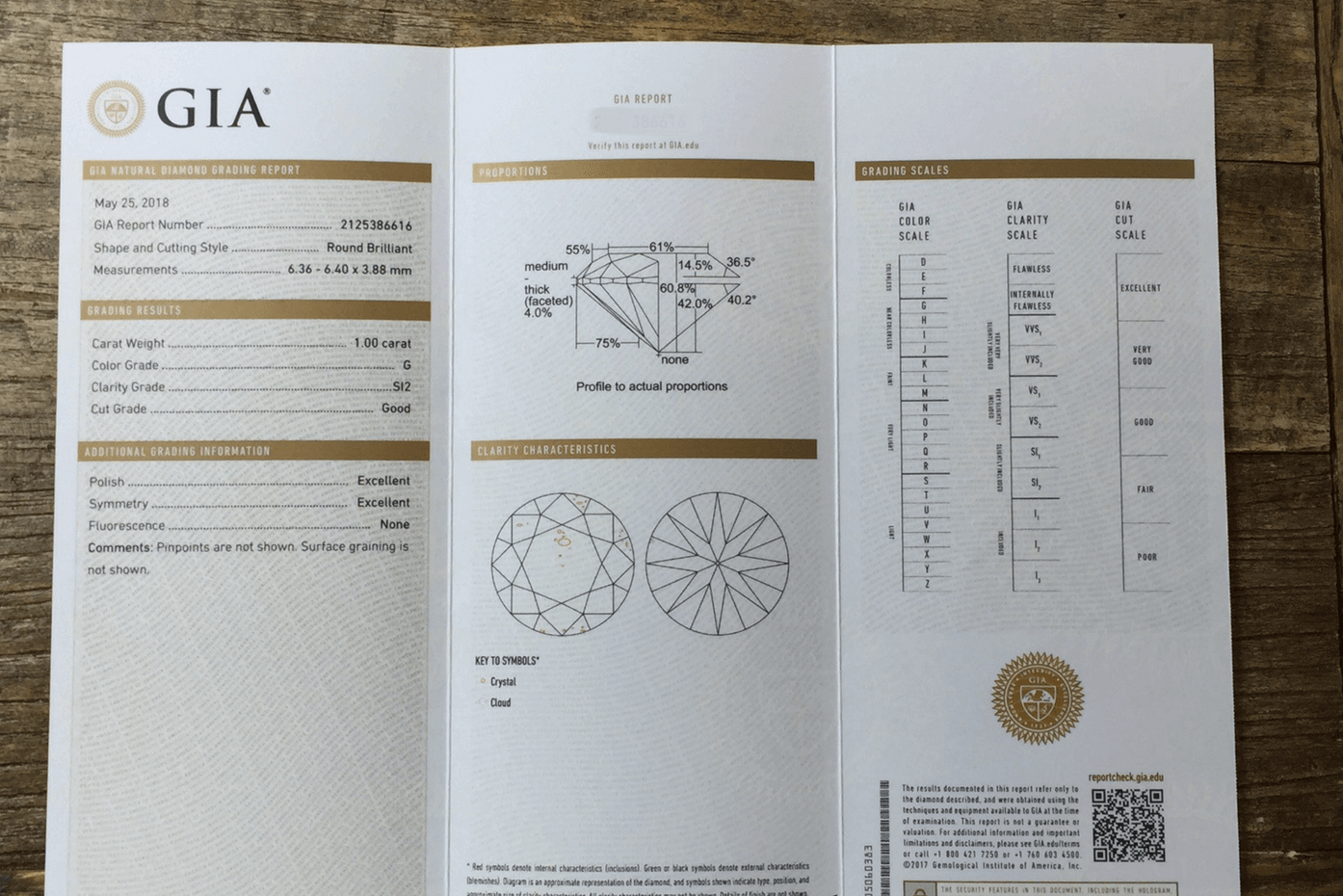
When it comes to diamonds, individual characteristics play a huge role in the uniqueness and value of the stone. The Gemological Institute of America (GIA) –one of the world’s foremost authorities in gem grading– developed the 4Cs (color, clarity, cut, and carat weight) of diamond grading, now widely recognized as a global benchmark of grading.
A GIA Diamond Grading Report is an assessment of the 4Cs of your diamond – all the technical details you would want to know about your stone.
Reports may be useful, but only if you know how to read them! To start with, the GIA provides different kinds of reports. These are full Diamond Grading Reports, Diamond Dossiers, and eReports, which are online only.
If you look at the left-hand of your full GIA diamond report, you’ll see the report number – a unique number pegged to your diamond. If you go to gia.edu, you can click “report check” on the top menu bar and type in your report number – this will pull up all the information in your report.
Below your report number, you’ll find the shape and cutting style, followed by the measurements of your stone. The shape and cutting style tells you the shape of your diamond and the style of the cut. For example, a “rectangular step cut” is an emerald cut diamond; and a “square modified brilliant” is more frequently known as a princess cut diamond.
Then you have the measurements of your stone – the physical dimensions of the stone measured to the nearest hundredth of a millimeter.
The carat weight is simply the weight of the stone measured to the hundredth of a carat. Color is graded from D (colorless) to Z (showing tints of color). In the context of diamonds, the color grade is based on the lack of color. Once you get to G-H color, you can start to see slight hints of color with the naked eye when you look at the diamond face-down. If a diamond shows an intensity of color beyond the Z color grade, the Fancy Color grading system is applied.

Next you’ll find a column for clarity. Clarity starts with Flawless, meaning there are no inclusions. Your stone is flawless inside and out, a perfect example of nature’s intention. But perfection also comes with a high premium!

As we go down the clarity scale, the stones contain more inclusions and imperfections. For example, after the Internally Flawless clarity grade, you have VVS1. This means the stone is very very slightly included, with minor inclusions you can only see under high magnification with a microscope. Once you get down the list to diamonds graded I1 to I3, these stones tend to contain inclusions you can see with your naked eye.
Then comes the cut grade, based on a scale from excellent to poor. The cut grade tells you how well the diamond is cut to return light to your eye. This affects the brilliance and sparkle of the diamond, so it’s an essential characteristic to look out for. How perfectly is it cut? For example, if the stone is too flat and shallow, light leaks out – and the stone can look glassy and devoid of sparkle. Or if the stone is cut too deep, just like the shallow stone, it won’t be sparkly – but for the opposite reason, that it traps light.
At the bottom left of your report you’ll find “Additional Grading Info.” The polish and symmetry relates to the finish of the diamond, graded from excellent to poor. These grades affect the shape appeal (pleasingness of the shape to the eye) and cut grade as they contribute towards the diamond’s appearance.
Polish refers to how smooth the diamond’s surface is. A well-polished diamond can produce undistorted light transmission and crisp reflections. Symmetry refers to how the stone’s facets are aligned in relation with one another. For example, with a heart-shape diamond, do both sides reflect each other like mirror images?
Finally, fluorescence is the degree of intensity and color with which some diamonds glow when they’re exposed to ultraviolet (UV) light, often blue. Fluorescence may sometimes affect the overall value of a diamond when considered in tandem with all the other characteristics of the stone.

A diamond plot is a unique diagram of your stone (think of it like a fingerprint) mapping out all the clarity characteristics of the diamond. Blemishes, which are external, are marked in green on the plot, while inclusions – internal imperfections in the diamond, such as crystals (mineral formations) – are marked in red.
The proportions diagram shows all the technical measurements for the cut of the stone. This is useful for people who wish to analyze the diamond based on numbers like table percentage, depth percentage, crown angles, pavilion angles and girdle thickness.

Last but not least, you will sometimes see inscriptions for stones listed. That means the diamond’s been laser inscribed with either its unique GIA number or other additional details. Any extra miscellaneous information that is important and relevant for the stone will be listed under the “comments” section. If the stone has received any sort of treatment – for instance, irradiation to change the color of the diamond – that will be noted.
When buying a diamond, it is extremely important to understand the different factors that contribute to the overall value. Having the tools to read a GIA grading report is not just key in finding the perfect stone for you, it’s empowering knowledge that will make you feel confident you’re making the best choice.
©2011-2025 Worthy, Inc. All rights reserved.
Worthy, Inc. operates from 25 West 45th St., 2nd Floor, New York, NY 10036